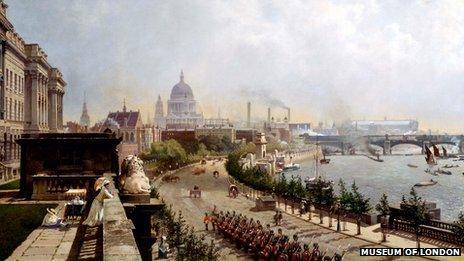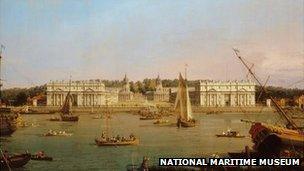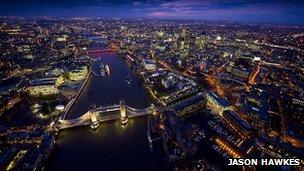Diamond Jubilee: The remarkable tale of the River Thames
- Published

Following the building of the Embankment, great buildings and palaces that were once sat on the Thames were now stranded from the river
If you are among the crowds lining the banks of the Thames for the Jubilee Pageant on Sunday, spare a thought for the river itself, which was once the capital's principal transport artery.
The Thames was once the "noblest river in Europe", according to The Spectator's Joseph Addison in 1712.
Yet by 1858 it had become "a Stygian pool reeking with ineffable and unbearable horror", as described by former Prime Minister Benjamin Disraeli in 1858.
Before 1750, a single bridge crossed the Thames in the capital, the eponymous London Bridge, while the river was what many described as "London's grandest street", the city's primary transport artery and one of the world's busiest waterways.
For most Londoners, the Thames functioned as a thoroughfare, a bustling working river and a source of entertainment, with lord mayors, royalty and people from every class travelling by river, and watermen rowing aristocrats and merchants to their destinations.
Robert Blyth, a historian from the National Maritime Museum which is hosting a Royal River exhibition, looking at 500 years of history of the Thames, goes as far as to say London was a "river city" before the 19th Century comparable to Venice.
Pleasure gardens
"The streets of London were narrow, dirty, rather mean streets and land transport wasn't very comfortable," he said.
"So if you wanted to travel in style and in comfort and if you also wanted to be seen then it was the river for you."

The Thames functioned as a thoroughfare, a bustling working river and a source of entertainment.
Access to the principal royal palaces of Tudor England including Whitehall, Greenwich and Hampton Court, as well as the Tower of London, was primarily from the river.
"If you were royal and wanted the maximum number of people to see you then the the river banks provided the best arena for that," said Mr Blyth.
In the 18th Century, the Thames was also the place to be seen by fashionable London society.
Riverside pleasure gardens became places of leisure - for musical entertainment, promenading and dining - with socialites particularly enjoying the gardens of Vauxhall and Ranelagh.
'Civic pride'
London was also a huge trading port - becoming the biggest in the world - with ships coming up the Thames, right into the heart of the city.
And the Thames was paramount to the growth of the British Empire with great fleets setting sail from the capital to embark on voyages of exploration.
But with the Industrial Revolution, London's population rapidly increased, and the infrastructure failed to keep up.
Meanwhile, the arrival of the flush lavatory led to human waste flowing directly into the river, turning it into a giant sewer.
"Mudbanks became covered in sewage in the baking sun and it stunk to high heaven," said Mr Blyth.
By the time of the Great Stink in the summer of 1858, pollution in the river reached such an extreme that MPs were seen entering Westminster with handkerchiefs at their faces.
To tackle the putrid river, which was becoming a national disgrace, Sir Joseph Bazalgette designed a sewer network for central London and massive embankments narrowing the Thames but attempting to cleanse it and restore London's health.
"It was partly about Victorian civic pride," said Mr Blyth.
"London's great imperial capital shouldn't be polluted by this sewer running through it."
But by cleaning up the river, London inadvertently turned its back on it.
All of the great buildings and palaces that were once sat on the Thames were now left stranded from the river.

Boris Johnson has promised to increase riverboat trips on the Thames to 12 million a year.
New bridges and tunnels traversed the river, while increased use of the sprung coach was aided by newly paved and cobbled roads.
Meanwhile, as the Palace of Westminster rose from the ashes of the old parliament buildings, its original design envisaged the monarch arriving for the state opening of parliament at a great water-gate by boat, but this was scrapped in favour of the main entrance facing away from the Thames.
"The river today is very quiet compared with how it would have been in the 18th and 19th centuries," said Museum of London historian Alex Werner.
But he added: "I think as the population of London rises the river will come more into play as one of the main transport arteries of the city."
And if the London's re-elected Conservative mayor has anything to do with it, use of the Thames may be on the rise again.
Boris Johnson has promised to quadruple riverboat trips on the Thames from around three million to 12 million a year.
The mayor's office has said an action plan will be published this year.